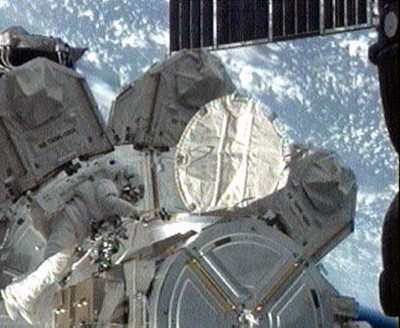Mon, Nov 24, 2008
Endeavour Now Scheduled To Land November 30
Astronauts Shane Kimbrough and Steve Bowen (shown below) began
the fourth and final planned spacewalk of the STS-126 mission to
the International Space Station about 20 minutes ahead of schedule,
switching their spacesuits to internal battery power at 1:24 pm EST
on Monday.

During the planned six hour and 30 minute activity, the
spacewalkers will complete the installation of trundle bearing
assemblies on the starboard Solar Alpha Rotary Joint (SARJ), and
clean and lubricate the port SARJ.
That joint has been the focus of activities on the first three
spacewalks of Endeavour’s mission to the station. It has been
used sparingly since increased power consumption and vibrations
were noticed in September last year. A test of the joint rotating
in the mode to automatically track the sun will be done early
Tuesday morning to judge the repair work
In addition to repairs to the SARJ, spacewalkers will also
install a camera on the Port 1 truss and attach a Global
Positioning System antenna on the Japanese Experiment Module
Pressurized Section.
The spacewalkers exited the station shortly after receiving word
from NASA their visit to the ISS has been extended by 24 hours.
Endeavour will now undock from the station Friday, one day later
than planned, and will return to Earth Sunday afternoon.
NASA extended the mission to give crews onboard the ISS some
more time to troubleshoot the off-and-on Urine Processor Assembly
(UPA), part of a new water reclamation unit installed onboard the
station. NASA reports the UPA ran for almost three hours Sunday --
the longest successful operation to date -- and processed about a
gallon of liquid, after modifications by Expedition 18 Commander
Mike Fincke and Endeavour Mission Specialist Don Pettit. The system
then shut down.
On Monday, Fincke will install two bolts in the UPA's
distillation assembly to further reduce vibration. Mission
officials believe those vibrations are causing problems for the
UPA's motor assembly... and hope the added measures will relieve
the problem, so to speak.
If the UPA remains uncooperative, NASA will need to fly a new
motor to the ISS... potentially delaying the planned Summer 2009
deployment of the first six-person crew onboard the ISS. The water
reclamation unit is vital to supporting an expanded crew
complement.
More News
Light Gun A handheld directional light signaling device which emits a brilliant narrow beam of white, green, or red light as selected by the tower controller. The color and type of>[...]
"The journey to this achievement started nearly a decade ago when a freshly commissioned Gentry, driven by a fascination with new technologies and a desire to contribute significan>[...]
Aero Linx: JAARS, Inc. For decades now, we’ve landed planes on narrow rivers and towering mountains. We’ve outfitted boats and vehicles to reach villages that rarely se>[...]
"Our driven and innovative team of military and civilian Airmen delivers combat power daily, ensuring our nation is ready today and tomorrow." Source: General Duke Richardson, AFMC>[...]
Aircraft Conflict Predicted conflict, within EDST of two aircraft, or between aircraft and airspace. A Red alert is used for conflicts when the predicted minimum separation is 5 na>[...]
 ANN's Daily Aero-Term (04.20.24): Light Gun
ANN's Daily Aero-Term (04.20.24): Light Gun Aero-News: Quote of the Day (04.20.24)
Aero-News: Quote of the Day (04.20.24) ANN's Daily Aero-Linx (04.21.24)
ANN's Daily Aero-Linx (04.21.24) Aero-News: Quote of the Day (04.21.24)
Aero-News: Quote of the Day (04.21.24) ANN's Daily Aero-Term (04.21.24): Aircraft Conflict
ANN's Daily Aero-Term (04.21.24): Aircraft Conflict



